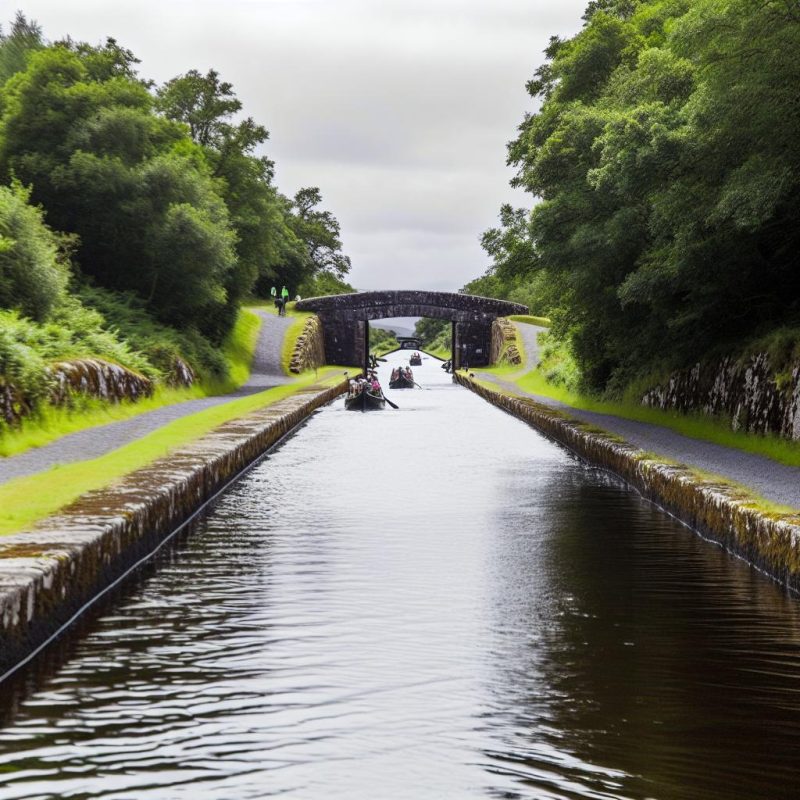The Crinan Canal: A Brief Overview
The Crinan Canal, situated in the picturesque landscapes of Scotland, is an exemplary feat of 19th-century engineering that draws a connection between the Sound of Jura and Loch Fyne. This strategically important waterway, which stretches approximately 9 miles, offers a crucial shortcut through the Kintyre Peninsula.
Historical Background
In the late 18th century, maritime routes around the Mull of Kintyre were not only perilous but also time-consuming. Hence, a more direct pathway was conceptualized, leading to the construction of the Crinan Canal. The initial plans for the canal emerged in the 1790s, spearheaded by the eminent engineer John Rennie. The project officially broke ground in 1794. By 1801, the canal had become navigable, marking a significant milestone in the facilitation of regional maritime trade.
The decision to venture into the construction of the canal was grounded in the necessity to expedite the transportation of goods. The canal became instrumental in connecting the Scottish west coast with the River Clyde, by providing a safer and more efficient route for vessels. To accommodate the elevation changes, 15 locks were incorporated into the design, a testament to Rennie’s visionary engineering.
Engineering and Design
The engineering prowess exhibited during the creation of the Crinan Canal was quite advanced for its time. A crucial part of its construction involved extensive earthworks, as large quantities of earth needed to be moved to form the canal’s path. The construction also featured the strategic use of stone masonry for the lock systems, creating structures resilient to water pressure and capable of withstanding the harsh Scottish climate.
Originally designed to facilitate the movement of sailboats, the canal adhered to the technological needs of its time. However, it has since undergone several modifications and updates to accommodate modern vessels, especially those used for leisure. This adaptability has enabled the canal to maintain its relevance over the centuries, offering transport for a variety of boats, which includes the popular leisure crafts frequently seen today.
Current Usage and Preservation
In contemporary times, the Crinan Canal has largely transitioned from being a commercial waterway to a hub of recreational activity. Affectionately dubbed “Britain’s most beautiful shortcut,” it attracts a variety of tourists, from boating enthusiasts to photographers eager to capture the canal’s scenic vistas. The canal meanders through an enchanting natural environment, presenting travelers with panoramic views of the surrounding landscapes.
Ongoing efforts are directed towards the canal’s preservation, aiming to retain its historic character while simultaneously ensuring it meets the safety and accessibility standards demanded by modern users. These preservation initiatives often involve meticulous maintenance of the canal’s infrastructure, including the locks and waterway pathways, to ward off deterioration and sustain the canal’s operability.
For those interested in exploring more about the canal, its history, and its current functioning, the Scottish Canals website offers a comprehensive collection of resources detailing its storied existence and ongoing operations.
Cultural and Natural Significance
While the Crinan Canal is an engineering marvel in its own right, its importance transcends mere functionality. It is woven into the cultural fabric of the local communities, symbolizing a bridge between past and present. The canal has proven to be a magnet for tourism in the region, reinforcing its economic significance by drawing visitors from various corners of the globe.
Ecologically, the canal supports a rich and diverse ecosystem. The waterway and its environs provide a haven for numerous aquatic life forms, as well as terrestrial species inhabiting the land around it. This biodiversity makes the canal an attractive spot for nature enthusiasts, who can indulge in activities ranging from birdwatching to hiking. The lush surroundings offer an open invitation for exploration, encouraging visitors to discover the natural beauty that thrives alongside this man-made structure.
Throughout its existence, the Crinan Canal has stood as a testament to early 19th-century engineering ingenuity, continuing to offer valuable insights into the historical era from which it emerged. Moreover, it presents contemporary leisure opportunities, adding a rich layer of engagement for those who traverse its waters. The canal’s enduring legacy serves as a point of reflection on the harmonious blend of human innovation and natural beauty.

